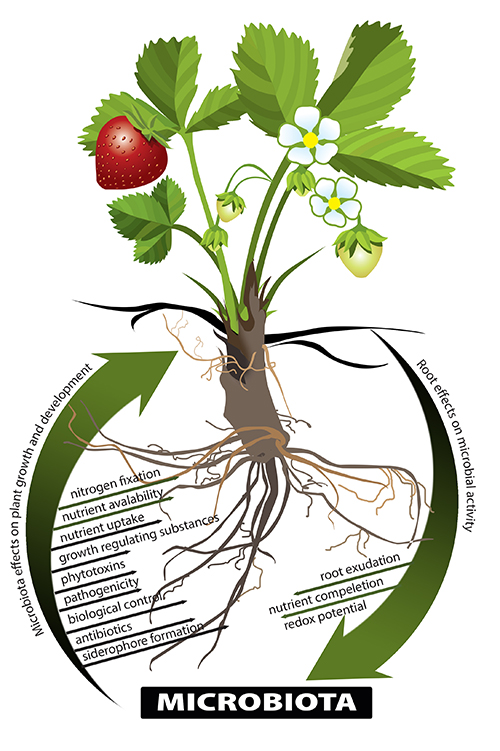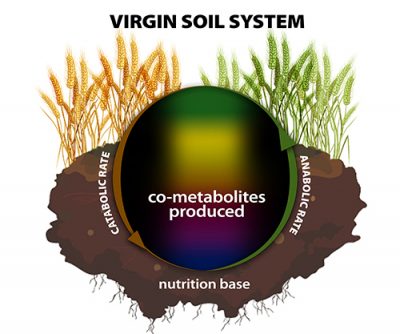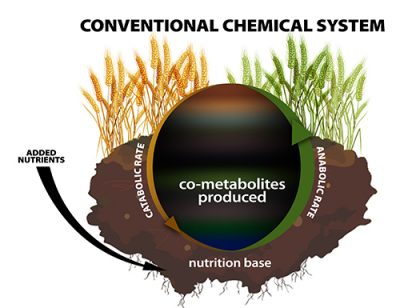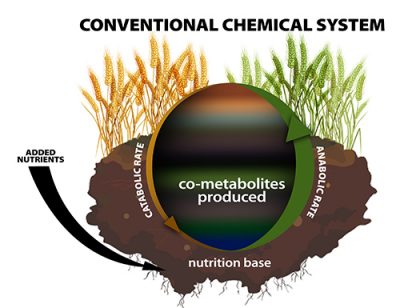Our Biological Management in Organic Farming in California
At ABC Organics, we understand that farming is not just about producing crops but also about ensuring the balance between soil fertility, plant health, and yield. This is why we use the "ABC3 Approach to Soil Fertility," which integrates biological, mineral, and disease management strategies in organic farming.
Our biological management in organic farming in California cultivates healthy living soil and plant ecology, emphasizing microbial community structure and biodiversity. This system increases nutrient uptake and promotes natural plant growth, resulting in improved crop yield.
Our management system includes organic fertilizer designed to enhance soil fertility using natural sources. Our specially designed fertilizer helps improve crop health without introducing harmful chemicals into the environment. Our organic fertilizer is an excellent resource for fertilizing crops, creating healthier soil, and reducing environmental impact.
In addition, ABC Organics also utilizes a mineral management system that is all about using appropriate mineral inputs while extracting existing minerals from soils. This results in more efficient use of fertilizers, reduced soil erosion, and increased soil health.
Lastly, we also have a disease management system that uses limited chemical inputs to prevent and manage crop disease, ensuring production without sacrificing yield or soil fertility. This approach contributes to a healthier environment and safer working conditions for farmworkers.
Learn More
Continue browsing this page to learn more about what we do. ABC Organics works to help farmers in California achieve sustainable and organic farming practices. We believe that a balanced, integrated approach to farming results in larger yields, healthier plants, improved soil quality, and a cleaner environment. Join us in our commitment to sustainable and organic farm production.

Biological Management System
Our biological management system uses analytical tools to determine microbial community structure, function, and biomass. The goal is to establish and culture a healthy, living soil and plant ecology.
Healthy soil is achieved by developing a sound microbial environment that is conducive to healthy root and plant development, controlling diseases, and maximizing the productive capacity of the soil.
Establishment of a healthy soil micro-flora will maximize water-use efficiency, maximize nutrient uptake, encourage a stable, aerated soil structure, Produce biological metabolites, encourage coil humus formation and decreases nutrient runoff, creating an environmentally sound, financially profitable, and socially responsible overall farming practice.
The processes involved include the properly manage use of cover crops, well-made compost and judicious use of manures and other soil amendments. In the modern farming system, these practices can all be enhanced or replaced by the use of ABC Organics’ soil harvest products.
Mineral Nutrition
The ABC mineral nutrition management system uses soil, tissue, and sap testing to determine qualitative and quantitative nutrient status and to make corrections before problems occur. This differs greatly from the growers’ standard, as it addresses issues before they cause damage to your crops or a loss in production.
Maintaining a balanced soil fertility program must utilize the right mineral resources. Sole reliance upon chemical inputs has been the standard for soil and plant nutrition for the last century. Virgin soil has been depleted of its accumulated biological compounds and biodiversity as a result of mismanaged and overuse of chemicals. By limiting the use of chemical inputs, the grower can ensure that they do not negatively impact the soil and plant ecology. For example, it is commonly preferred to use gypsum to correct saline soils and improve structure; however, in most cases, the judicious use of lime would be more advantageous because of its increased available calcium. Another example would be the excessive use of nutrients that lead to imbalances that harm the soil’s micro-flora, which induces plant stress.
Disease Management Systems
The ABC disease management system reduces the farmer’s dependence on chemicals by enlisting all 3 principle mechanisms of biological control.
Competition-Antibiosis: By providing a wide range of organisms, our soil harvest products out-compete pathogens for space, coating the leaves and roots of your plants with symbiotic organisms as opposed to pathogenic ones. Beneficial bacteria and fungi produce antibiotics, limiting the ability for pathogens to infect plants. By inoculating plants early on and throughout their life cycle, the farmer gains the ability to protect his crops using products that are non-toxic and assist in maintaining the fertility of his soils.
Systemic Induced Resistance: Compounds created by a healthy microbial ecosystem have been shown by countless studies and field trials to prime plants “immune systems” By using know organic and naturally sourced compounds the soil harvest product line nourishes the plants' natural abilities to resist diseases and insects.
Parasitism/Predation: By limiting the need for systemic biocides, fungicides, and insecticides, nature’s systems of predatory insects, nematodes, fungi, and bacteria can be maintained. This gives the farmer 24-hour-a-day, 7-days-a-week, natural protection for his plants.
“An ounce of prevention is worth a pound of cure”—Benjamin Franklin
ABC Organics’ Approach to Soil Fertility vs. a Chemical Approach
In 1855, Justus Von Liebig’s discovery that plants are fed by water-soluble substances started a revolution in agriculture. However, this revolution progressed in a different direction—far from the truly original thinking of Von Liebig. Von Liebig’s discovery reads:
“Plants take up water-soluble nutrients.”
This discovery became internationally understood, unfortunately, after a single word was added to Von Liebig’s statement:
“Plants take up water-soluble ionic nutrients.”
This single addition changed the truth of his discovery. The first to recognize the important misunderstanding was Von Liebig himself. This addition leads to an interpretation that neglected Von Liebig’s total work in agriculture. Liebig’s other findings were:
“Man must regard nature as a unit, a whole, and everything that occurs in nature works together as knots in a net.”
“Diseases of plants are diseases of soil.”
“We must treat the disease, not the symptom.”
It is important to understand that if the soil is living and healthy, the plants will be strong and healthy, with natural resistance against disease as will the creatures and people that consume them. This is the basic pillar of biological farming.
The chemical approach sees the soil only as a place to anchor the plants: hydroponics being their environment of choice. The chemical approach takes into account only the minerals, a limited range of elements.
Comparing them to the crop to be grown, they determine the amounts of these nutrients to be used chemically without considering the biological needs of the soil/plant relationships.
Although this approach is still widely used, it has been modified to take into account the influence each mineral has to another mineral. The chemical purist may not look at all known nutrients the plant needs for total nutrition.
For example, vanadium and chromium, though usable and needed by plants in special conditions, will not be acknowledged in the chemical approach.
Recently some chemical purists have been using VAM, and some limited inoculants containing a handful of microorganism species to help with their system.
Yet, their approach to these microorganisms is still the same purist, boxed-in system of using the soil as a container and not a living environment. This approach is detrimental to farmers and their soil.
The ABC Organics approach to soil fertility looks at the whole of soil-plant relations. This approach accounts for the biochemical functions in soils and in plants, not just mineral nutrient applications. Three components are implemented to achieve balanced, total nutrition for plants and soil.
A biological management system establishes a healthy living soil and plant ecology with an emphasis on microbial community structure and diversity. Mineral nutrition management systems use appropriate mineral inputs while harnessing the vast, existing natural resources beneath our feet, the soil. A disease management system utilizes natural defenses with limited chemical inputs.
Hydroponics and soil farming are two distinctively different systems of plant anabolism (biosynthesis). The hydroponics environment is kept sterile and separated from the outside environment. In soil farming the soil is always interacting with its surroundings—immediate and remote.
The importance of soil quality for soil-based anabolism is often undervalued. Soil quality is needed to provide a complete nutritional base, not only for plants, but also for the microorganisms in the soil.
Minerals in soil systems have complex pathways and are dynamic compared to the static presence of minerals in hydroponics. For example, in hydroponics, there is no leaching of minerals. However, leaching is a fact in soils. In hydroponics, all media and equipment is sterilized before every crop.
However, pathogens are a fact in every soil. Therefore, what is learned in hydroponics cannot necessarily be applied to living soils. Soils must be viewed as living; hence the soil-farming process is directed anabolism, not just of the plant but also of the soil.
To increase the output of a field simply means to increase the rate of anabolism within the soil. So one has to know the limitations of the anabolism and address them to increase the farm’s overall output.
One of the limits of production can be the genetic limit of the plants, but in almost all instances, this limit is not reached in farming due to its expression as assisted by the grower. Most of the time, the true limiting factor in production is the nutrient supply and the timing of the plant during its growing season.
The chemical approach to increasing anabolism goes back to Liebig’s misrepresented discovery and states:
“Plants take up ionic minerals and the minerals are the limiting factor to increased production, therefore all we need to do is supply the minerals ‘directly’ to the plant.”
Let us examine soil metabolism. The limiting factor of anabolism is, as stated, the mineral supply; but the mineral supply in turn is dependent on the rate of catabolism (mineralization and humification). In natural (non-farmed) soils, the rate of anabolism over a period of several years is equal to the rate of catabolism during the same period.
The humus content of the soil (from humification) acts as storage for nutrients. The rates of anabolism and catabolism are not equal in any given year, but only in a period of several years which is made possible by the humus. In a year when weather may be very advantageous for plant growth, the rate of mineralization is not able to supply the needed nutrients for the increased plant growth.
The humus, through microbial action, will be able to release some of the absorbed minerals for plant use, allowing the rates of catabolism and anabolism to be unequal. Figure 1 shows this basic metabolic cycle in soils. In the chemical-purist approach, the rate of anabolism is increased for soil-systems by the addition of free minerals to the soil as in Figure 2.

The rainbow colors of the illustration to the left represent well-balanced co-metabolite production. The width of this line represents the number of co-metabolites produced. The following illustrations depict the effects of different approaches to soil life.
In Figure 2 below, the chemical addition of free minerals bypasses (short-circuits) the catabolic process. By bypassing the catabolism, a major factor is being overlooked: the vast complexities of metabolic byproducts. These co-metabolites play a role in the regulation of the anabolic processes, influence the microflora, and indirectly influence the soil structure, water, mineral-holding capacity, crop nutrition, and the phytopathogenity of the soil.

The detrimental influence of the chemical purist approach on the soil is taking place relatively slowly. Over time, the huge buffer capacity of the soil’s organic matter reserve is mineralized without replenishment and is slowly broken down, with changes in soils becoming more noticeable. More and more farmers, when looking back twenty years, note the ever-increasing dependence on chemicals.
The approach that ABC Organics is promoting, from over 20 years of research and practical application, is the incorporation of specialized catabolic and anabolic processes into today’s high yield (intensive) farming with precisely targeted chemical use. This will increase the amount and variety of co-metabolites produced during production, in turn balancing the catabolic and anabolic processes. The chemical applications are moved to a form of true supplement for soil and plant.

Under the ABC Organics Soil System, the biological inputs are increased and mineral nutrients are used wisely.
ABC Organics’ Biochemical System
Since most of the co-metabolites are active in minuscule quantities, the application of such directly to soils becomes a practical approach to controlling the activity of the microflora.
Proper studies of the microbial community structure include bacteria, fungi, algae, actinomycetes, protozoa, nematodes, pathogens, etc., which are important factors, and has been a guiding principle in our management strategies.
The natural life cycle of fields must be kept functional through the additions of organic matter, mineral fertilizers and biological inputs.
Careful attention needs to be given to the selection of the right quality and quantity of biological inputs and mineral fertilizers in order to provide balanced nutrition for our crop and soil life. This action in the whole cannot be replaced with water-soluble fertilizers alone.
During the growing season, as plants fix carbon dioxide by photosynthesis, 10–25% of this fixed carbon finds its way back to the soil through the roots as root exudates, even if all residues including roots are removed at the end of the season; this carbon input into the soil is very important in sustainable farming.
When plants prosper and release high amounts of carbon to the soil, increases of organic matter (humus) and microbial biomass are then possible.
Slowly the organic materials are broken into smaller parts; at the same time many are again combined and used for building hormones, enzymes, vitamins, and proteins for the rapidly multiplying microorganisms and crop. Antibiotics are produced to secure an area for growth, free from other microorganisms.

Antibiotics are not harmful to the organisms that produce them. To many other microorganisms, they are detrimental, thereby freeing space and energy supplies for specific fungi and actinomyces to flourish.
This diagram represents the Growers’ Standard Management Practice today. As can be seen, the grower does not utilize much control over his farming system.
For example, the farmer will have little control over the decomposition of plant residues by the soil biota and therefore little control over his organic base and organic pool quality.
Therefore, there is little control over the mineral pool (that can then be adjusted only by mineral supply) and consequently over plant growth.
In the Grower Standard, the farm manager utilizes fertilizer with only the crop in mind. The influence the fertilizer has on the microbiology is not predetermined, and therefore the microbial pool is not likely to be in balance and will have a low biodiversity and low biomass, and poor to marginal production of natural PGRs.
The foliar applications used contain only minerals or undiversified biological compounds. Their use is without considering their influence on the biota. Since the biota becomes imbalanced, and as such considered phytopathogenic, many pesticides need to be used. In general, such a system will not produce the full potential of the crop.
What We Can Do for You
In the ABC Organics management system, we help the grower to utilize more and better control over his farming by eliminating most of the stress factors for the crop. The farm manager utilizes fertilizer with not only the crop in mind, but the biota and the soil as well. The influences the fertilizer has on the microbiology are predetermined and the addition of co-metabolites enhances microbial function.
Therefore, the microbial pool is balanced and has a high biodiversity and high biomass with increased PGRs. The foliar applications contain minerals and diversified biological compounds that target specific functions. Since the biota is balanced, fewer pesticides need to be used. In general, the ABC Organics system will produce higher yields and superior quality.


